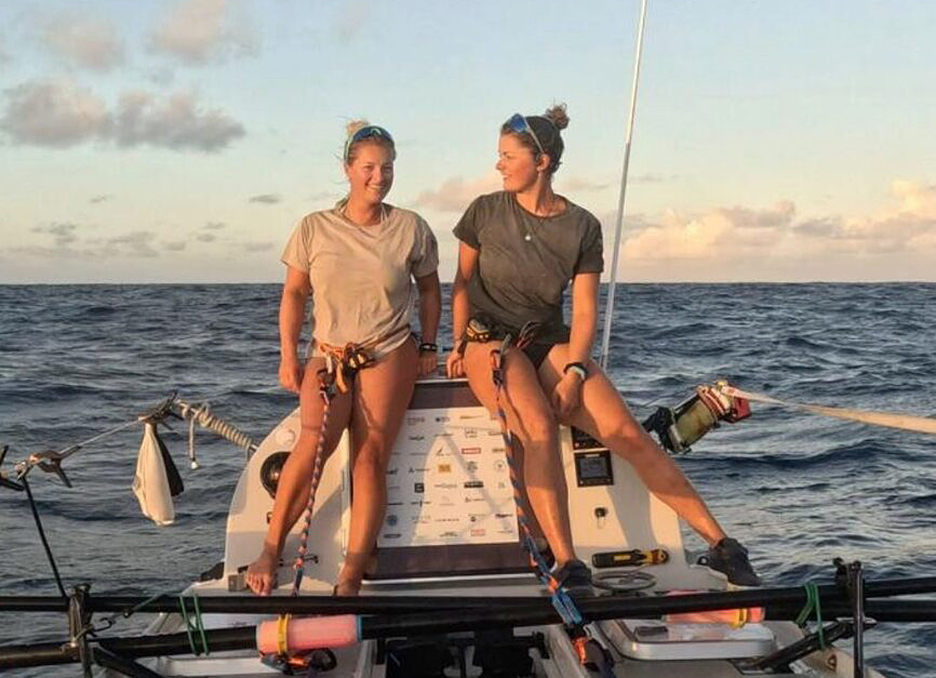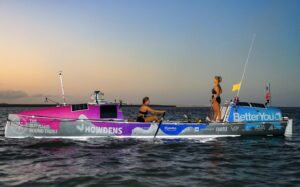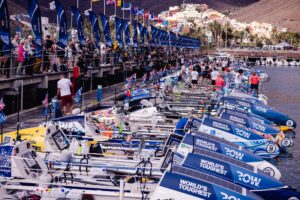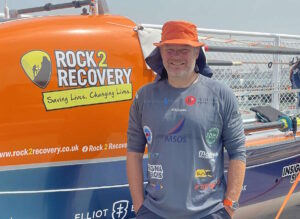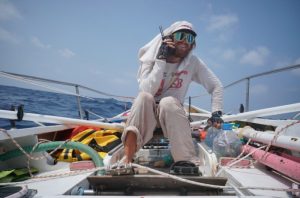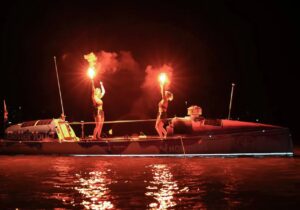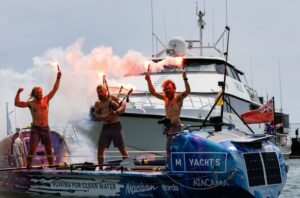Since our last ocean rowing roundup, four crews have completed their journeys across the Indian, Arctic, and Pacific Oceans.
Pacific Ocean
Seas the Day (UK): Jess Rowe and Miriam Payne are steadily making their way from Peru to Australia. They started in April, but turned back and restarted in May because of a broken rudder.
Their second attempt has not been without equipment issues. For months, they have been struggling with failing batteries, which have affected their electrical systems. With minimal energy available, they have switched everything off except the autohelm. This meant they had to use their emergency watermaker instead of their electric one, but they were making it work until disaster struck and the intake filter broke. Payne came to the rescue with her knickers. Using one of her precious remaining clean pairs, she made a DIY filter and solved the issue.
On July 23, the pair hit the halfway point of their journey, crossing 6,500km. Just a few weeks later, they decided to add an extra 800km to their row. They had been heading for Sydney, but — realizing how busy that section of coast is — decided to move their endpoint to Brisbane.
New weather forecasts predicting strong headwinds have forced them to change plans yet again and reroute to Cairns. Though they will hopefully escape the headwinds, they will now have to navigate through various islands and the Great Barrier Reef.
Thrown overboard
MacLean Brothers (UK): Jamie, Ewan, and Lachlan MacLean are on the final stretch of their 14,000km row from Peru to Australia. A huge moment for the brothers came on August 19, when they officially entered Australian waters after four months at sea.
“2,800 nautical miles (5,185km) across the Atlantic now seems like a paddle up the Firth of Forth after the almost 8,000 nautical miles (14,000km) on the Pacific Ocean it took to get here,” they wrote, comparing the journey to their previous Atlantic crossing.
They started rowing on April 13 and wanted to reach Australia by August 2. Equipment issues and difficult weather made that impossible. At the end of July, the winds were so strong that they suffered three knockdowns (when the boat turns onto its side). In one terrifying moment, Lachlan was thrown overboard.
Lachlan had been switching seats with Ewan in the middle of the night when a seven-meter wave knocked him into the water. Lachlan said he “was at the mercy of the sea” while Jamie frantically pulled him back into the boat using the safety line.
The terrible weather continued, constantly pushing them east. “No matter how hard I try, every attempt to push west, or south, or even north, is in vain,” Jamie said as they were forced onto para-anchor.
Since setting off, celebrities Mark Wahlberg, Ewan McGregor, and Ben Fogle have called to encourage them. They have 1,200km left to go.
Choppy seas and a broken autohelm
Tame the Kraken (U.S.): Father-and-son duo Tim and Harrison Crockett completed their row from California to Hawaii on July 21 after 47 days, 14 hours, and 53 minutes. The pair were hoping to break a speed record and finish in 45 days or less. Ultimately, a mixture of choppy seas and a broken autohelm slowed them down.
For most of the row, they tried to keep their heads down and not focus on the end point, but by the last few days, the conversation turned to the meals they would eat when they were back on dry land and how good it would be to have a hot shower.
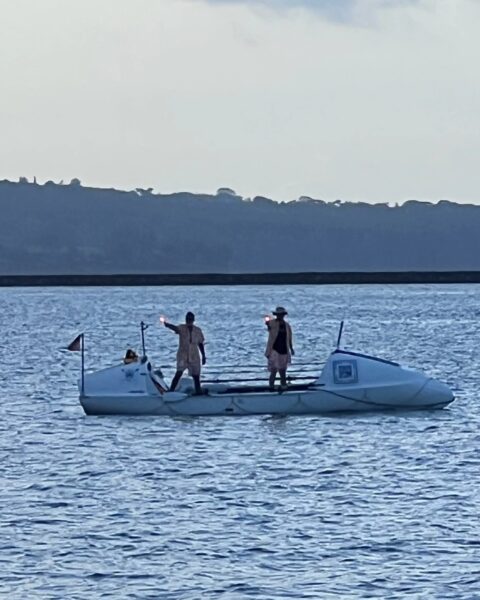
Father-and-son duo Tim and Harrison Crockett. Photo: Tame the Kraken
The only frustration in those last few days was their speed. Despite good currents and helpful winds, they were not going as fast as they would have liked. In a last-ditch attempt to pick up the pace, Tim jumped overboard for one final scrub of the hull to remove as many barnacles as possible. This helped slightly, spurring them on.
Tim is no stranger to ocean rowing, having previously rowed the Atlantic. But he found the Pacific far harder: “Despite having a second rower, despite it being less distance, despite it being a shorter amount of time on the water, this has been relentless. The Pacific started out being very cold and relentless, and ended up being very hot and relentless!”
Circumnavigating the globe by human power
Louis Margot (CH): Louis Margot is attempting to circumnavigate the globe by rowing and cycling. He is currently in the middle of his second rowing leg and fourth leg overall.
Starting in Switzerland, Margot cycled to Portugal and then rowed across to Colombia. Hopping back on a bike, he headed across South America to Peru, where he started his second row. He is rowing 14,000km from Peru to Indonesia.
He paused in Hiva Oa, part of the Marquesas Islands, to rest and make repairs, but restarted his row in June.

Louis Margot. Photo: Louis Margot
On July 24, he was officially a third of the way across the Pacific and treated himself to a small bottle of beer to celebrate. At the same time, he began facing some technical difficulties. Two of his four solar panels stopped working, meaning he had to reduce his energy usage; his electronic compass also started playing up and was not connecting properly to his navigation system.
Over the last few weeks, he has made his way past several small Pacific islands. This has meant lots of fishing traffic and also some incredible marine wildlife. Now he is heading towards the Bismarck Sea and Papua New Guinea.
Indian Ocean
Ocean Revival (UK): Matthew Mason, Jake Mattock, Matthew Inglesby, and Mathew Hemmings completed their 8,500km journey from Australia to Kilifi, Kenya, in 72 days and 10 hours. Originally aiming for Dar es Salaam in Tanzania, they changed course after discovering its port has no slipways.
Spending just over two months at sea has not been easy for them. The weather has been changeable; July brought huge swells that capsized the boat. Though the boat righted itself, the equipment and crew were thrown about the cabin. Inglesby was left with deep lacerations on his face, and Mattock suffered a black eye. They also lost their tracker in the capsize.
With everything soaked from huge waves that persisted for weeks, the men were constantly wearing damp kit and suffered from salt sores all over their bodies. In the final week, their steering broke. They were forced to use foot controls to make their way along the coastline and through busy shipping lanes.
Reverse rowing
Untamed (BG, NL, CN, UA): Evgeny Sudyr, Liu Yong, Ralph Tuijn, and Stefan Ivanov landed in Tanzania after 65 days, 10 hours, and 42 minutes at sea. The four-man crew started their row in Australia and had planned on landing in Mombasa, Kenya. They have not given a reason why they changed course, but it was likely a combination of the weather and steering issues.
They wanted to become the first team to finish this 8,300km route in under 75 days. At one point, this looked incredibly unlikely. Currents were pushing them north instead of west, and at the start of July, they came within 180km of Madagascar and thought they might have to be rescued. Luckily, that was not the case, but just days later, they lost their second and final rudder, making steering nearly impossible.
Rather than quit, they reversed their rowing positions and rowed backwards, which gave them a little more control over the steering. In the remaining weeks, they picked up speed and also cut 300km from their journey by landing in Tanzania rather than Kenya.
Around Britain
52 Degrees North (IE/UK): David Irving (IE), Rod Tredgett (UK), and Scott Brown (UK) started their row around Britain from Tower Bridge in London. After making their way down to the south coast, they moved clockwise around mainland Britain and headed up the west coast. They crossed over to Ireland after a few weeks and made their way along the Irish coast, finally crossing the Irish Sea to Scotland on July 18.
Here, they faced one of the trickiest parts of their journey, rowing between the Isle of Jura and Scarba through the Gulf of Corryveckran. The narrow strait is known for its whirlpools and strong currents that can create waves over nine meters high. After making it through the strait, they continued up the west coast of Scotland, reaching the milestone of Cape Wrath — the most northwesterly point of their journey — on July 30.
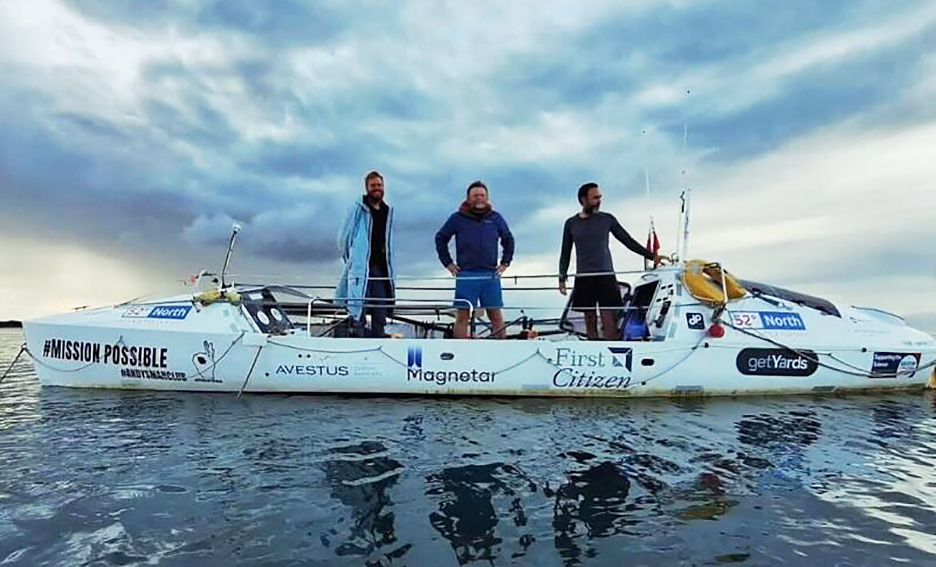
David Irving, Rod Tredgett, and Scott Brown. Photo: 52 Degrees North
Just days later, Storm Floris hit. Initially, the team pushed hard to reach Scrabster Bay, whose headlands and cliffs offered some protection. The storm was predicted to bring gusts of 100kph to the Scottish coastline. However, as weather predictions worsened, they decided to anchor to a fixed pontoon in Scrabster Harbour and wait out the storm on land.
When the team could row, they had made great progress, but difficult weather meant they were on anchor for 24 of their first 42 days — far more than expected. After over a week waiting out Storm Floris, the team eventually decided to abort their row; they had run out of time to finish.
Another row aborted
Row with the Flow GB (UK): This week, Row with the Flow GB also called time on their attempt to row around Britain. The six-man crew waited weeks for a good weather window. With time running out, they changed their route and rowed clockwise as opposed to counterclockwise around the island.
Starting in Eyemouth on the east coast of Scotland, this decision initially helped them, but conditions around Britain’s coast have been difficult all summer. Making their way down the east coast and crossing into England, the first few weeks went fairly smoothly. Then, at the start of August, the UK was hit by Storm Floris, and the team had to wait out the weather at Norfolk and Suffolk Yacht Club.
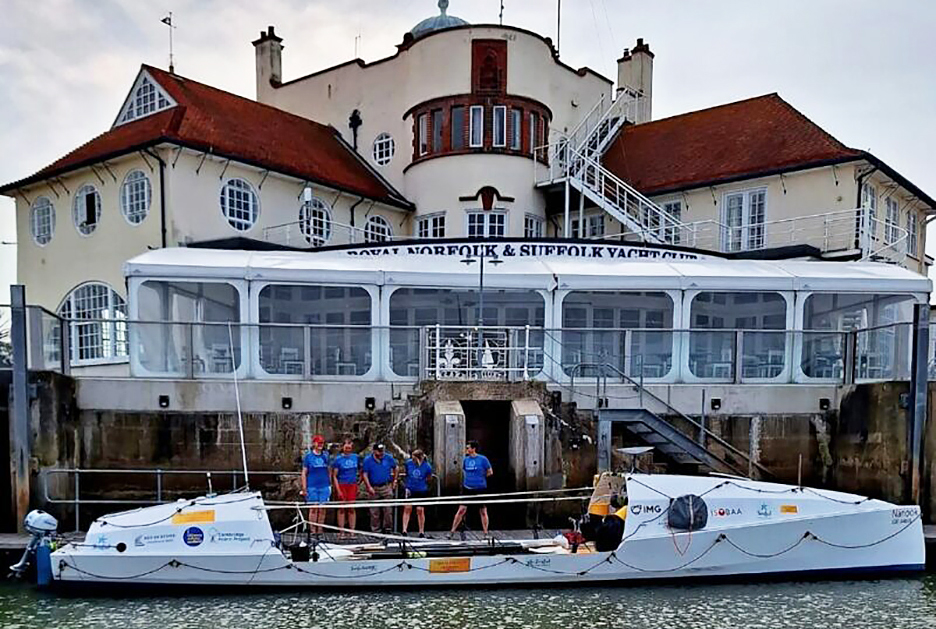
The six-man Row with the Flow GB team. Photo: Row with the Flow GB
The crew had taken days off work for the row, so time was limited. Once again, they changed their plan. Instead of continuing around Britain, they would head back up the east coast and circumnavigate Scotland.
They made it back into Scottish waters on August 14, hoping to use the Forth Clyde Canal and Crinan Canal. Sadly, the sea entrance to the Forth Clyde Canal was closed, and forecasts show the only other possible route would likely be hit by an incoming storm.
Arctic Ocean
The Arctic Challenge 2025 (U.S.): On July 15, Andrew Tropp, Jimmy Graham, Hannah Huppi, and John Huppi completed their 1,000km row across part of the Arctic Ocean. Starting in Tromosø, Norway, they reached Longyearbyen, Svalbard, in just 10 days. This cut five days off the previous record set by the Ocean Revival foursome in 2023.
